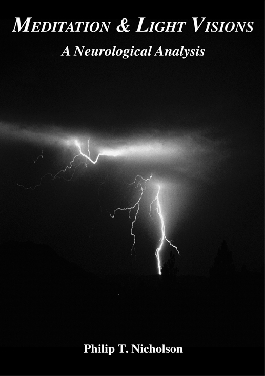VISIONS OF GREEN LIGHTS:
A SCIENTIFIC PERSPECTIVE
(c) 2011 Philip T. Nicholson
What happens in the brain
when green visions appear?
1. AMORPHOUS, EVER-CHANGING GREEN MISTS
- In the actual visions, the amorphous, ever-changing mists do not cover the entire visual field; they occupy a relatively small space and look like "bubbles," "clouds," or "curtains" of light.
- The green mists are generated by "cortical slow waves" that would normally become active during a drowsy, detached transition to sleep. To generate these brainwaves, large numbers of neurons in the cortical regions begin firing in rhythmic (synchronous) pulses at a rate of less than one pulse per second (<1 Hertz). This oscillation is officially designated "stage 1 NREMS" (non-rapid-eye-movement sleep). As meditators put themselves in a relaxed, detached state, cortical slow waves become active.
- The characteristics of green mists, which have amorphous, ever-changing shapes, embody the same characteristics as the cortical slow waves that generate them. Cortical slow waves are "spontaneous, periodic, synchronous bursts" that erupt at unpredictable locations and at unpredictable times, then expand slowly in unpredictable directions, remain in the visual field for a brief interval, and then disappear.
2. LIGHT-RINGS THAT SHRINK IN DIAMETER
- The animation of the green light rings is very accurate. The only shortfall is that the background black of the visual field should be darker—dark enough that the black rings flowing into the visual field would be barely perceptible to even an attentive observer and might often be subliminal.
- Visions of the green light-rings that shrink steadily in diameter, as if "receding" away from the viewer, are generated by the shift from "stage 1" to "stage 2 NREMS." During a normal transition to sleep, stage 2 begins at the moment someone loses consciousness and falls asleep. The brain wave that triggers this shift is a synchronous sleep rhythm called a "spindle burst" because its EEG pattern is shaped like a spindle of wool. It usually takes only 3 to 6 spindle bursts, on average, to put a person to sleep.
- Spindle bursts are initiated in the thalamus, an important structure in the subcortical brain that relays all incoming sensory signals to higher processing regions in the cerebral cortex. Wrapped around the thalamus is a sheet of inhibitory neurons (called the thalamic reticular nucleus, or RTN) that control which sensory signals get forwarded. When all of the inhibitory neurons in the RTN discharge in rhythmic bursts, this sets in motion the spindle waves of inhibition that temporarily suppress the ability of vision-relay neurons to send signals up to the higher-processing centers in the visual system. Because of this suppression, meditators see a dark band in the visual field. But once a spindle wave moves past a set of vision-relay neurons and releases them from inhibition, the neurons recover their equilibrium and fire "rebound spikes." The rebound spikes are relayed up through the visual pathways where they register in the consciousness of meditators as a band of light that moves in tandem behind the dark band generated by the spindle wave's inhibition.
- The tandem waves set in motion by spindle bursts acquire their ring shape from the anatomical circuitry of the vision-relay center in the thalamus (called the lateral geniculate nucleus, or LGN). The way this happens can be illustrated using an analogy that accurately reflects the functional anatomy of the LGN. The visual field is made up of all the visual signals that are relayed by the neurons in two LGNs, one located in each hemisphere of the brain. Think of the two LGNs as constituting, in effect, a dome-like structure. Now imagine that a wave of excitation begins around the base of the dome and then moves up the sloped surface towards the top. That wave of excitation will acquire a ring-shape because of the shape of the dome that conducts the flow of the wave. In a similar manner, when a spindle wave of inhibition—or a tandem wave of rebound spikes—ignites around the base of the dome of the LGNs and moves up, these ascending waves generate the vision of a dark ring that shrinks steadily in diameter, followed by a ring of bright light.
- In normal circumstances, a person loses consciousness and falls asleep at the moment that spindle bursts begin to discharge, but meditators are able to preserve consciousness despite the activation of spindle bursts because the behaviors of converging the eyes and focusing attention on the visual field with an attitude of expectancy combine to produce a dramatic increase—more than 300%--in the excitability of vision-related neurons. For more detailed information about this or about any of the other subjects addressed in these notes, see below.
FOR MORE INFORMATION:
To see other works by this author, and to download sample materials, go to this website:
<www.philipnicholson.com>
